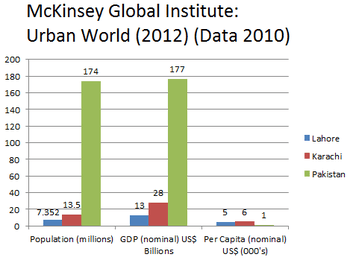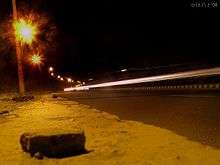Economy of Lahore

The economy of Lahore has a diversified base spanning from telecommunication, information technology, manufacturing industry, engineering, pharmaceuticals, steel, chemicals and construction material. As a major urban centre, the economy of Lahore has relatively prospered. Lahore is hailed as the industrial belt of Pakistan and is home to the largest IT park in Pakistan. It is the country's second largest economic hub and the commercial capital of Punjab. In 2008, the city was ranked with high efficiency to be classified as a gamma world city.
The economy is also enhanced by Lahore's historic and cultural importance. Being the capital of the largest province in Pakistan brings the city one of the largest development budgets in the country. It is also the most advanced in terms of infrastructure, having extensive and relatively well developed road links to all major cities in Punjab and Khyber Pakhtunkhwa, a rail link with India and the province's biggest international airport. It also has the most developed communications infrastructure in the province, which includes a wide network of fiber optic telephone and cable lines, GSM mobile network, IPP and WiMax. It has the most developed education and health sectors in Pakistan, making it the economic, Technological, political and educational hub of the Pakistan. As Lahore expands, former residential areas are being turned into commercial centres, and the suburban population is constantly moving outwards. This has resulted in the development of the Liberty Market, M. M. Alam Road, the new Jail Road (which has some of the largest office buildings in Lahore), and the Main Boulevard.
Gross domestic product

As of 2008, the city's gross domestic product (GDP) by purchasing power parity (PPP) was estimated at $40 billion with a projected average growth rate of 5.6 percent.[2] This is at par with Pakistan's other economic hub, Karachi, with Lahore (having half the population) fostering an economy that is 51% of the size of Karachi's ($78 billion in 2008).[2] The contribution of Lahore to the national economy is supposed to be around 13.2%.[3][4] Central to Lahore's economy is the Lahore Stock Exchange (LSE), Pakistan's second largest stock exchange. Lahore has offices of several Pakistani government corporations including the Water and Power Development Authority (WAPDA) and Water and Sewage Authority (WASA). Food and restaurant businesses remain open all night. Metro, Makro and Hyperstar (Carrefour) have situated their headquarters in Lahore.
Communications
There is a network of metalled roads in the district. It is connected other major cities and towns with a very sophisticated network of roads. It is also connected with the capital of Pakistan and other major cities through the M2 Motroway link. The Lahore Railway station is one of the oldest station in the country, and serves as the main connecting point for rail services to many cities and routes. The station building is another example of the magnificent architectural beauty of the city. There is an International Airport in the cantonment area, P.I.A. and other international airlines have routes to all major destinations of the world. Lahore airport is one of the busiest airport of the country after Karachi international terminal. A newly built international terminal, Allama Iqbal International Terminal, helps in the locomotion of passengers to other countries. It greatly facilitate and improves the air transits to and from the Lahore city.
Lahore Stock Exchange
The Lahore Stock Exchange is Pakistan's second largest stock exchange after the Karachi Stock Exchange. It is located in Lahore, Pakistan. The Lahore Stock Exchange (Guarantee) Limited came into existence in October 1970, under the Securities and Exchange Ordinance of 1969 by the Government of Pakistan in response to the needs of the provincial metropolis of the province of Punjab. It initially had 83 members and was housed in a rented building in the crowded Bank Square area of Lahore. The number of listed companies has increased to 519 since its inception. With 37 sectors of the economy and 519 listed companies with total capital of Rs. 555.67 billion having market capitalization of around Rs. 2.51 trillion . The LSE has 152 members of which 81 are corporate, and 54 are individual members. The LSE was the first stock exchange in Pakistan to use the internet and currently 50% of its transactions are via the internet.
The Lahore Stock Exchange has opened branches in the industrial cities of Faisalabad and Sialkot for trading. The Sialkot branch is referred to as the "Sialkot Trading Floor".
Industries
Lahore is the second largest financial hub of Pakistan and has industrial areas including Kot Lakhpat and the new Sundar Industrial Estate (near Raiwand). A major industrial agglomeration with about 9,000 industrial units, Lahore has shifted in recent decades from manufacturing to service industries.[5] Some 42% of its work force is employed in finance, banking, real estate, community, cultural, and social services.[5] The city is the country’s largest software producing center,[5] and hosts a growing computer-assembly industry.[5]
Small-scale industries
Lahore is the hub of handmade carpet manufacturing in Pakistan.[6] At present, hand-knitted carpets produced in and around Lahore are among Pakistan's leading export products, and their manufacturing is the second-largest cottage and small industry. Craftsmen in Lahore produce almost every type of handmade carpet using popular motifs such as medallions, paisleys, traceries, and geometric designs. The Lahore Design Centre at the Punjab Small Industries Corporation maintains a separate section of carpet designing to experiment with new designs. Lahore is known for single-wefted designs in Turkoman and Caucasian style and double-wefted Mughal types.
Projects
Among the projects currently under construction in Lahore is the long-delayed Lahore Expo Centre.[7]
Lake City is a resort and residential development planned on the outskirts of Lahore. Covering an area of more than 2,104 acres (851 ha), the resort will include lush green parks, sinuous lakes, an 18-hole regulation golf course and other features.
Defense Raya Golf Resort, also under construction, will be Pakistan's largest and Asia's largest golf course. The project is the result of a partnership between DHA Lahore and BRDB Malaysia. The rapid development of large projects such as these in the city is expected to boost the economy of the country.[8] Among the many other projects under construction in Lahore are: Pace Tower (24 floors, under construction), Mall99 (21 floors, under construction), Lahore Expo Center (under construction),[7] Expo Center tower (approved), IT Tower (23 floors, under construction), Alamgir Tower (31 floors, under construction), DHA Haly Tower (low rise, under construction), Lahore Ring Road (under construction), Lahore Sports City (approved), Kot Lakhpat elevated expressway (approved), Lahore Rapid Mass Transit System (vision), Xinhua Mall (20 floors, under construction), Lahore-Sialkot motorway (under construction), Boulevard Heights (19 floors, under construction), Pearl Continental Tower (40 floors, 152 meters, proposed), LDA Tower (40 floors, approved),[9] Bank Square Gulberg (vision), Pace Circle and Hyatt Regency (12 floors, under construction) and Tricon Corporate Tower (18 floors, under construction).
Transportation

Lahore is one of Pakistan's most accessible cities and the only city in the country where one can find public and private transportation 24 hours a day and 7 days a week. This includes public buses, as well as thousands of rickshaws and taxis, which run on compressed natural gas to reduce pollution in the city. About 75% of residents have their own conveyances. The roads in the city are well maintained and are broadened when needed to meet increasing demand. Notable means of transport include:
- Lahore Ring Road
- Grand Trunk Road (G.T. Road)
- Sammi Daewoo Bus Service
- Lahore Central Railway Station
- Allama Iqbal International Airport
See also
References
- ↑ "Urban world: Cities and the rise of the consuming class". Retrieved 2012-09-02.
- 1 2 "Global city GDP rankings 2008–2025". PricewaterhouseCoopers. Retrieved 12 February 2010.
- ↑ Inskeep, Steve (1 June 2008). "Karachi Calling!". NPR. Retrieved 6 July 2009.
- ↑ "In Pictures: The 10 Biggest Cities Of 2025". Forbes. 19 March 2008. Retrieved 6 July 2009.
- 1 2 3 4 Asian Development Bank. "Rapid Mass Transit System Project" (PDF). Retrieved 1 January 2009.
- ↑ "A Brief Introduction to Carpet Weaving History of Pakistan". Al Rug. Retrieved 1 July 2007.
- 1 2 Expo Center Lahore. YouTube. Retrieved on 22 October 2011.
- ↑ Defence Raya – Overview of Defence Raya in DHA Lahore Pakistan. Zameen.com. Retrieved on 22 October 2011.
- ↑ Leading News Resource of Pakistan. Daily Times (10 February 2008). Retrieved on 22 October 2011.